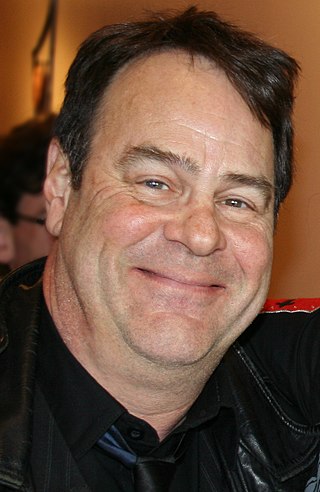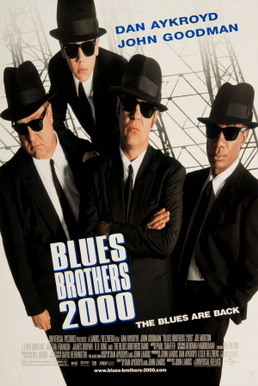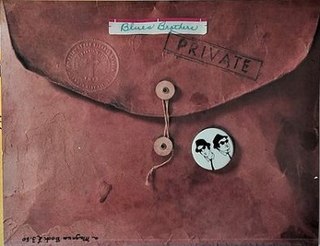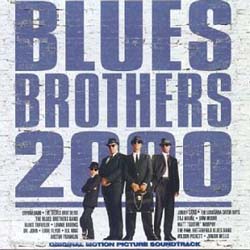
John Adam Belushi was an American comedian, actor, and musician. He was one of the seven original cast members of the NBC sketch comedy show Saturday Night Live (SNL). Throughout his career, Belushi had a personal and artistic partnership with his fellow SNL star Dan Aykroyd, whom he met while they were both working at Chicago's Second City comedy club.

Daniel Edward Aykroyd is a Canadian and American actor, comedian, screenwriter, producer, and musician.

The Blues Brothers are an American blues and soul revue band founded in 1978 by comedians Dan Aykroyd and John Belushi, who met and began collaborating as original cast members of Saturday Night Live.

Blues Brothers 2000 is a 1998 American musical action comedy film directed by John Landis from a screenplay written by Landis and Dan Aykroyd, both of whom were also producers, and starring Aykroyd and John Goodman. The film serves as a sequel to the 1980 film The Blues Brothers. It also includes cameo appearances by various musicians.

Bullitt is a 1968 American neo-noir action thriller film directed by Peter Yates and produced by Philip D'Antoni. The picture stars Steve McQueen as the title character, San Francisco police detective Frank Bullitt, who pursues a group of mobsters after they kill the witness he's been assigned to protect. The cast also features Robert Vaughn, Jacqueline Bisset, Don Gordon, Robert Duvall, Simon Oakland and Norman Fell. The screenplay by Alan R. Trustman and Harry Kleiner was based on the 1963 novel Mute Witness by Robert L. Fish, under the pseudonym Robert L. Pike. The film was made by McQueen's Solar Productions company, with his partner Robert Relyea as executive producer. Lalo Schifrin wrote the original jazz-inspired score.

John David Landis is an American filmmaker and actor. He is best known for the comedy films that he has directed – such as The Kentucky Fried Movie (1977), National Lampoon's Animal House (1978), The Blues Brothers (1980), An American Werewolf in London (1981), Trading Places (1983), Three Amigos (1986), Coming to America (1988) and Beverly Hills Cop III (1994) – and for directing Michael Jackson's music videos for "Thriller" (1983) and "Black or White" (1991).

The Dodge Monaco is an automobile that was marketed by the Dodge division of Chrysler Corporation. Introduced as the flagship of the Dodge product line, the Monaco was introduced for the 1965 model year to replace the Custom 880, then later joined as a sub-model of the Dodge Polara. During its production, the Monaco was offered in several body configurations, including two-door and four-door hardtop sedans, four-door sedans, two-door convertibles, and station wagons.

A car chase or vehicle pursuit is the vehicular overland chase of one party by another, involving at least one automobile or other wheeled motor vehicle, commonly hot pursuit of suspects by law enforcement. The rise of the automotive industry in the 20th century increased car ownership, leading to a growing number of criminals attempting to evade police in their own vehicle or a stolen car. Car chases may also involve other parties in pursuit of a criminal suspect or intended victim, or simply in an attempt to make contact with a moving person for non-conflict reasons.

Vanishing Point is a 1971 American action film directed by Richard C. Sarafian, starring Barry Newman, Cleavon Little, and Dean Jagger. It focuses on a disaffected ex-policeman and race driver delivering a muscle car cross-country to California while high on speed, being chased by police, and meeting various characters along the way. Since its release it has developed a cult following.

The Gumball Rally is a 1976 American action comedy film, directed and co-written by Charles Bail, a former stunt coordinator also known as Chuck Bail, about an illicit coast-to-coast road race. It was inspired by the Cannonball Baker Sea-to-Shining-Sea Memorial Trophy Dash run by Brock Yates, which inspired several other films, including Cannonball (1976), Cannonball Run (1981), and Speed Zone (1989), as well as an actual event, the American Gumball Rally and Gumball 3000 international race.

The Dodge St. Regis is an automobile that was marketed by Dodge from the 1979 to 1981 model years. Replacing the Monaco, the St. Regis was the largest Dodge sedan, positioned above the mid-size Diplomat and Aspen. In contrast to both the Monaco and the Diplomat, the St. Regis was offered solely as a four-door sedan. Produced for a single generation, the St. Regis is one of the shortest-lived Dodge nameplates.

Police vehicles in the United States and Canada consist of a wide range of police vehicles used by police and law enforcement officials in the United States and in Canada. Most police vehicles in the U.S. and Canada are produced by American automakers, primarily the Big Three, and many vehicle models and fleet norms have been shared by police in both countries.

The Blues Brothers is a 1980 American musical action comedy film directed by John Landis. It stars John Belushi as "Joliet" Jake Blues and Dan Aykroyd as his brother Elwood, characters developed from the recurring musical sketch "The Blues Brothers" on NBC's variety series Saturday Night Live. The script is set in and around Chicago, Illinois, where it was filmed, and the screenplay is by Aykroyd and Landis. It features musical numbers by singers James Brown, Cab Calloway, Aretha Franklin, Ray Charles and John Lee Hooker. It features non-musical supporting performances by Carrie Fisher and Henry Gibson.

Blues Brothers: Private is a book published in 1980, designed to help flesh out the universe in which The Blues Brothers took place. Private was written and designed by John Belushi's wife, Judith Jacklin, and Tino Insana, a friend of John's from their days at The Second City.

Neighbors is a 1981 American black comedy film based on the novel of the same name by Thomas Berger. It was released through Columbia Pictures, was directed by John G. Avildsen, and starred John Belushi, Dan Aykroyd, Cathy Moriarty, and Kathryn Walker. The film takes liberties with Berger's story and features a more upbeat ending. The screenplay of the film is officially credited to Larry Gelbart, although it was extensively rewritten to Gelbart's public disapproval. Released two and a half months before Belushi's death, the film marks his last film performance.
Peter Aykroyd was a Canadian actor, comedian, and writer.
The Blues Brothers are a rhythm and blues band founded in 1978 by comedians Dan Aykroyd and John Belushi in character as Elwood and Jake Blues.

Blues Brothers 2000: Original Motion Picture Soundtrack is a soundtrack album that features the Blues Brothers. It is a soundtrack album to the 1998 film, Blues Brothers 2000, the sequel to the 1980 film, The Blues Brothers.

The Blues Brothers Show is a live show attraction located at Universal Studios Florida and formerly at Universal Studios Hollywood, based on the 1980 film The Blues Brothers.
Canadian Line Materials LTD. (CLM) was a Canadian siren manufacturing company which built civil defense sirens. These sirens were built and installed all over Canada to warn residents and military about incoming nuclear attacks from the USSR during the Cold War.




















